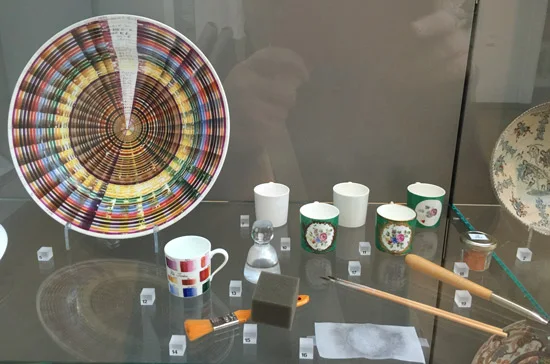So last week I took the lift to the sixth floor of the Victoria & Albert Museum and walked the whole length of the V&A - from end to end and round the corner - because that's how big the galleries need to be that house the V&A's Ceramics Collection. It's very very difficult to give you a sense of how the galleries just keep going one after the other.
 |
| View of part of Room 136 |
To say that the V&A collection of ceramics is monumental would be a gross understatement.
It's spectacular, it's staggering and it's stashed several pieces deep in very tall and very deep display cabinets which line the gallery walls - and the occupy the middle as well.
In fact, as the website says.....
Here are links to some of the explanations of what the Galleries (Rooms 133-145) have to offerThe V&A houses the greatest and most comprehensive collection of Ceramics in the world.
Below is a picture essay of some of the objects I photographed in the galleries.
Plant Motifs and Art (#2) at the V&A) and the green celadon ware of Japan, China and Korea for some time - but the programme made me think I needed to widen my horizons and find out more.
 |
| Iznik pottery |
 |
| some celadon pieces |
 |
| However colours can also be a lot more bold - these were from China I think |
 |
| The colours cross the centuries. These are I think from the 20th century |
This is a small part of the Majolica Collection.
 |
| Majolica 1500-1575 (aka as 'maiolica') |
 |
| Stoneware, Lead glazed earthenware - between 1300 and 1700 |
 |
| This is earthenware by Bernard Palisy - made between 1565 and 1585 Lead-glazed earthenware with cast, moulded and applied decoration and coloured lead glazes My favourite is on the right - but I'd not seen the smaller one (with frogs) on the left before. This is 'probably made by Palisy or follower' status |
This was from the section devoted to painting porcelain. I loved how the artists kept their equivalent of a set of colour charts for mixes and tonal values of different colours on a plate and cup
It was something of a surprise to get to the 20th century section and find that I recognised quite a few of the items in the display cases! (I'm that old!).
______________________
If you'd like to see more of the two judges of 'Pottery Bakeoff' as I like to call it - these are their websites - worth taking a look.
- Kate Malone's work is sensational! I think the reason I like it a lot if that she and I are visually stimulated by the same sort of natural objects
- Keith Brymer Jones's pieces are a lot nearer to the commercial end of potting - he's the man behind all those pottery mugs and plates with one word imprinted on to them

No comments:
Post a Comment
COMMENTS HAVE BEEN CLOSED AGAIN because of too much spam.
My blog posts are always posted to my Making A Mark Facebook Page and you can comment there if you wish.
Note: only a member of this blog may post a comment.